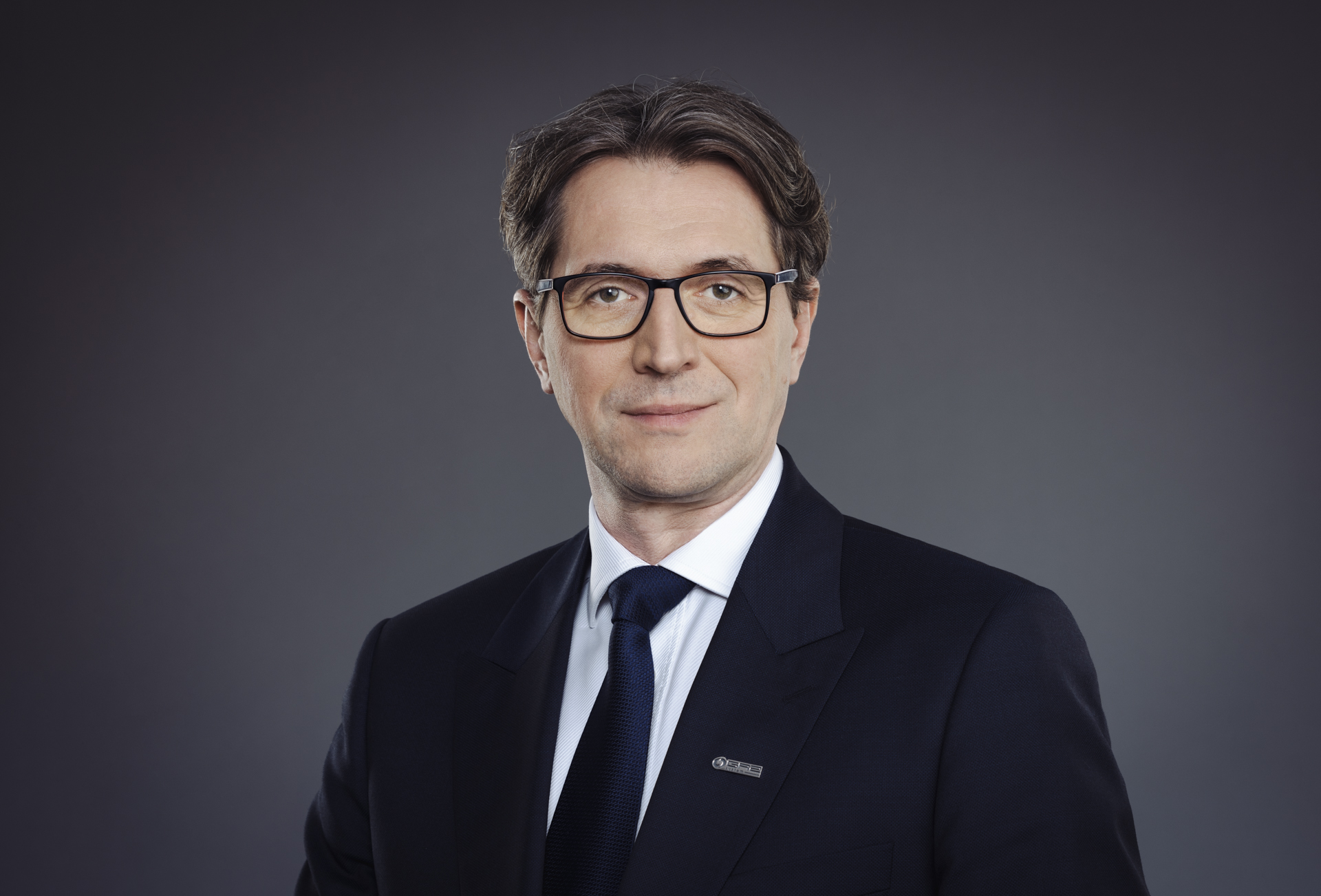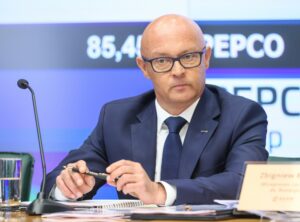„We have recently signed a charter agreement for a FSRU with a large Japanese contractor,” says Sławomir Hinc, president of Gaz-System. „We are moving to the implementation phase of the agreement,” he told BiznesAlert.pl.
BiznesAlert.pl: Gaz-System is opening a new chapter related to the energy transition, but first you need to finish the FSRU in the Bay of Gdańsk. There were various economic justifications behind the project, but what is the rationale in terms of hard security in the face of the war in Ukraine?
Sławomir Hinc: The FSRU program is the last major project related to the diversification and security of the national transmission system. This is the third element of the infrastructure, that completes the so-called the Northern Gate, increasing the reliability and flexibility of gas supplies for our customers on the territory of Poland. The situation that took place in the Baltic after the outbreak of the war in Ukraine gives us additional arguments for the implementation of this project.
Is it going to be a backup LNG terminal?
At the FSRU in the Bay of Gdańsk, we have demand covering 100 percent of the terminal’s regasification capacity for 15 years. I think from the perspective of the user or users of the terminal in Świnoujście, the FSRU is an important tool for optimizing gas supplies.
Someone may say that Germany has five terminals, so why would Poland need two?
The annual consumption of natural gas in Germany is several times higher than in Poland, which is why our neighbors are building infrastructure tailored to their market, just as we adapt it to our needs. Poland needs two gas ports, both of which complement each other perfectly. In crisis situations, the infrastructure that is not there is the most expensive. The FSRU project will enable our customers to optimize LNG contracts, while at the same time calmly secure peak demand during the winter period.
Why did you decide to charter instead of buying?
Chartering, which essentially means bearing operational costs for the duration of the unit’s use, is somewhat less burdensome for users because these costs do not appear immediately but are gradually spread across the entire period of the terminal’s operation.
Will the FSRU only supply natural gas to the grid? Could it be used for other purposes in the future, when arguments about orphaned assets arise?
The main task of the FSRU terminal at the moment is to increase the supply of LNG regasification and then supply natural gas to meet national and regional demand. And this is its main purpose. However, I do not hide the fact that in the future we will analyze whether it is possible to use the infrastructure that will be created in the Bay of Gdańsk in a different way, for example, whether it will be possible to supply decarbonized gases.
How to convince environmentalists, some of whom protest against the FSRU as unnecessary and excessive?
I think the main argument is about energy security. Additionally, we should consider the role of gas as a transition fuel, which will be introduced into electricity generation to replace energy previously produced from coal. In the near future, gas will continue to play a very important role in the decarbonization of the Polish economy.
Does it contribute to the energy transition?
Yes, I definitely believe that this terminal also contributes to the energy transition.
Poland no longer imports gas from Russia. What will we do with the infrastructure of the Yamal gas pipeline stretching across the country?
The future use of this gas pipeline in our national gas transmission system needs to be discussed by its current owners and regulatory bodies.
Is it technically possible to ensure adequate pressure so that it only delivers across Poland and possibly to the west?
Yes, we are in the process of implementing investments in this regard, for example, the Lwówek compressor station at the Yamal gas pipeline will allow gas to be introduced with pressure allowing its transportation across Poland and collection at several points. However, in the case of the Yamal gas pipeline, these are control and measurement stations, i.e. the existing connection points with the system and the new planned connection points.
Will there be more of them to improve distribution?
Yes, looking from the west, we have a connection in Lwówek and a place where the Lwówek gas pumping station will be built and an expanded node. This will be the first point where large quantities of gas from the north will flow from the terminal and the Baltic Pipe. The next point will be the Długa Gościna system measuring control station, which also allows powering the national system both to the south, towards Poznań, and to the north. Another place is the Wydartowo station – a point where we are close to the Mogilno storage facility and we have the possibility of transporting gas to a place where we can store this raw material at its peak and possibly give it back. Of course, the Włocławek control and measurement station, i.e. the connection point in the vicinity of Gustorzyn, is another point of connection to the network. This is a key point of the system, the transmission direction to the north, but also to Warsaw, to Odolanów, in the direction of Wroclaw and the newly built gas pipeline Gustorzyn – Wronów in the direction of Lublin. And we have another point Ciechanów. Of course, this is primarily a power point of the large area of Warmia and Masuria, which has always posed a considerable challenge when it comes to ensuring adequate pressure. The last point on this path is Zambrów, which opens up the possibility of increasing supplies in the direction of Białystok, but also to Ostrołęka and supports the supply for the Poland – Lithuania interconnector (so-called GIPL) running from Hołowczyce to Santaka. The Ostrołęka power plant will be powered by this gas pipeline.
For many years, there have been discussions between Gaz-System and Ukrainian partners on whether to build a new gas connection to Ukraine. Is the ongoing war undermining this project in the perspective of a few years, or is there a chance this topic will be back on the agenda?
After the expansion of the system, as well as after the construction of the Gustorzyn-Wronów gas pipeline and the expansion of the entire system in the south of Poland, running from Lower Silesia through Upper Silesia in the direction of Podkarpacie, we have the technical capabilities to supply Ukraine through the Poland-Ukraine interconnection (the so-called GCP GAZ-SYSTEM/UA TSO). We assume optimistically high flexibility of gas flow in the system in the south-east direction. However, it is important to decide whether to provide the service continuously or intermittently.
There is an idea to connect Poland, Slovakia and Ukraine and create this hub right there. The goal is to ensure pressure in Ukrainian gas pipelines and transmit gas from the south to the east with our help – are these topics on the table?
We are still in direct talks with the operator of the Ukrainian system. Based on last year’s signal from the market about the demand for continuous capacity in the direction of Ukraine, together with Gas TSO of Ukraine, we have developed a solution for the so-called incremental capacity project, the implementation of which will allow to maintain transport in this direction. We hope that in the coming days both regulatory bodies will approve the project, and by early July, market participants will be able to confirm their demand in a binding and long-term manner, allowing us to move to the implementation phase.
Did Gaz-System participate in the creation of the hydrogen map of the European Union? What is the current plan of Gaz-System for the development of the hydrogen market?
Yes, we have ambitious plans in this area. The Nordic-Baltic hydrogen corridor project, of which we are a partner, is an international project involving several countries from the Baltic Sea through Poland to Germany. Putting the corridor project on the EU’s first hydrogen list of Project of Common Interest confirms that the Nordic-Baltic hydrogen corridor is seen as an important element of the planned hydrogen networks in Europe. Gaz-System is interested in other projects of hydrogen corridors, but I think that the topic is also important from the point of view of the Polish economy. Today we are looking at the potential of the market, both from the supply and demand side. So that we can solve the problem of decarbonisation as well as meet the challenges of the electricity system. The north of Poland is a place where we will eventually have large energy production, including from RES. Many wind and photovoltaic projects are being implemented there, and of course nuclear power will be built. On the other hand, we have a lot of customers in the south of Poland who are under pressure of decarbonization. Excess energy can be used to produce hydrogen and accelerate the decarbonization process. At this point, I see the role of Gaz-System as an entity creating a hydrogen network integrated with the European network. This is important for the implementation of Polish interests and the energy transition of the entire region.
Will there also be any mega projects, such as big hydrogen highways from north to south? Or somewhere closer? Locally from place of production to place of consumption?
The market study on the hydrogen map of Poland, which we are currently conducting, will reveal what volumes we are talking about and how we can approach this. It is not that a large transmission network on the scale of the whole of Poland will be created immediately. This system will be built in the same way as the gas network was created, that is, step by step from the places where the points of production will be located to the places of its consumption.
What role will the hydrogen map of Poland play in this context?
It will make it possible to design the skeleton of the hydrogen network, and then determine the further directions of its development in Poland. Perhaps it will also address topics related to large-scale renewable energy projects that are currently unable to achieve their goal, i.e. electricity production due to, for example, the inability to connect to the electricity grid.
What will be the biggest milestone for Gaz-System this year?
Transition to the implementation phase of the FSRU.
And when can that happen?
We recently signed a charter agreement for the FSRU with a large Japanese contractor, so now this is happening – we are moving to the implementation phase of the agreement.
Interview by Wojciech Jakóbik









